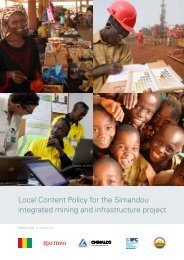Mapping Mining to the Sustainable Development Goals An Atlas
2gpArJN
2gpArJN
Create successful ePaper yourself
Turn your PDF publications into a flip-book with our unique Google optimized e-Paper software.
usually negotiated and codified through a signed<br />
agreement that contains mutual responsibilities,<br />
shared outcomes and, in some cases, agreed<br />
metrics <strong>to</strong> measure success.<br />
– Some countries establish trust funds <strong>to</strong> invest<br />
mining revenues in<strong>to</strong> local communities <strong>to</strong> improve<br />
public infrastructure or promote local economic<br />
development and companies sometimes participate<br />
in <strong>the</strong> management of <strong>the</strong> fund in collaboration with<br />
local communities and government. Additionally,<br />
companies may decide that <strong>the</strong> depth and breadth<br />
of <strong>the</strong>ir support <strong>to</strong> <strong>the</strong> SDGs and social, economic<br />
and environmental development is best served by<br />
establishing a separate foundation. There are<br />
many examples of <strong>the</strong> pros and cons of trust funds<br />
and foundations and how <strong>the</strong>y are governed<br />
that companies might review prior <strong>to</strong> making<br />
<strong>the</strong>se decisions. 4 One of <strong>the</strong> most important<br />
learnings is that foundations and trust funds do not<br />
replace <strong>the</strong> company’s responsibility <strong>to</strong> manage its<br />
social, environmental and economic impacts<br />
through its core business.<br />
Dialogue and engagement with<br />
communities and stakeholders<br />
Dialogue and engagement will inform <strong>the</strong> company on<br />
how best <strong>to</strong> integrate <strong>the</strong> SDGs in<strong>to</strong> its core business<br />
and underpin <strong>the</strong> opportunities <strong>to</strong> collaborate and<br />
leverage resources. Fully understanding <strong>the</strong><br />
relationship between <strong>the</strong> business and <strong>the</strong> external<br />
context requires communication, dialogue and<br />
engagement with local communities, local and national<br />
government, civil society, development agencies and<br />
o<strong>the</strong>r stakeholders. Dialogue and engagement aims <strong>to</strong><br />
build trust, share information and perspectives, and<br />
reach agreement on how <strong>to</strong> address mutually shared<br />
issues and concerns. This is a continuous and ongoing<br />
process that is systematic and based on transparency<br />
and mutual respect. Many resources are available <strong>to</strong><br />
inform how a company can build a transparent<br />
approach <strong>to</strong> engagement and relationship-building at<br />
<strong>the</strong> local, regional and national levels and some are<br />
noted in <strong>the</strong> “Selected resources” sections in <strong>the</strong><br />
chapters.<br />
Industry-related aspects <strong>to</strong> consider<br />
The contribution of an individual mining company <strong>to</strong> <strong>the</strong><br />
SDGs will take different forms depending on <strong>the</strong> local<br />
context, <strong>the</strong> nature of <strong>the</strong> extractive activity and <strong>the</strong><br />
mineral resource. To determine <strong>the</strong> best way forward,<br />
<strong>the</strong> opportunities and challenges in each chapter<br />
should be complemented with a review of <strong>the</strong><br />
company’s current sustainability programmes and<br />
performance, its particular industry characteristics, <strong>the</strong><br />
development phase, <strong>the</strong> business context and <strong>the</strong><br />
corporate framework. Specific issues <strong>to</strong> consider<br />
include:<br />
The mineral commodity and product value chain<br />
The mining industry extracts and processes a range of<br />
different minerals and metals that include precious<br />
metals (such as gold and platinum group metals), base<br />
metals (such as copper, zinc and nickel), industrial<br />
minerals (such as phosphate and limes<strong>to</strong>ne), iron and<br />
ferroalloys, bauxite, rare earths and energy minerals<br />
(such as coal and uranium). Each metal or mineral and<br />
its associated processing, sale and use have different<br />
economic, social and environmental benefits,<br />
constraints, impacts and risks. It also follows that<br />
different SDGs may be relevant <strong>to</strong> each mineral and<br />
metal and <strong>the</strong>ir associated value chains <strong>to</strong> differing<br />
degrees.<br />
The <strong>Atlas</strong> focuses on <strong>the</strong> applicability of <strong>the</strong> SDGs <strong>to</strong><br />
<strong>the</strong> extractive segment of <strong>the</strong> value chain ra<strong>the</strong>r than<br />
<strong>the</strong> final use of <strong>the</strong> mineral or metal itself.<br />
Never<strong>the</strong>less, it can be important for mining companies<br />
<strong>to</strong> consider that, in many cases, <strong>the</strong> product or service<br />
created by <strong>the</strong> use of <strong>the</strong> mineral has important<br />
relevance <strong>to</strong> particular SDGs, for example:<br />
– Fertilizers (e.g. phosphate) and micronutrients (e.g.<br />
zinc) – SDG2 (Zero Hunger) – These products<br />
contribute <strong>to</strong> improved food security and nutrition<br />
and global demand is likely <strong>to</strong> increase as human<br />
populations grow.<br />
– Thermal coal – SDG13 (Climate Action) – Barring<br />
large-scale deployment of carbon-capture and<br />
s<strong>to</strong>rage or some unforeseen technology, coalpowered<br />
electricity will continue <strong>to</strong> be one of <strong>the</strong><br />
greatest contribu<strong>to</strong>rs <strong>to</strong> climate change and <strong>the</strong><br />
associated emissions need <strong>to</strong> be phased out.<br />
– Rare earths and metals – SDG7 (Energy Access<br />
and Sustainability) – Many renewable energy<br />
technologies depend on rare earths and o<strong>the</strong>r<br />
metals that will play a critical role in <strong>the</strong> low-carbon<br />
economy. Base metals like copper will be a key<br />
component for <strong>the</strong> production of electric vehicles and<br />
zinc is necessary for s<strong>to</strong>ring renewably generated<br />
electricity.<br />
– Aluminium – SDG12 (<strong>Sustainable</strong> Consumption<br />
and Production) – Aluminium is highly recyclable,<br />
but is energy-intensive <strong>to</strong> produce. More<br />
sustainable consumption will probably require<br />
increased aluminium recycling. Aluminium, as a<br />
lightweight metal, can also reduce fuel<br />
consumption when used in manufacturing<br />
transportation systems.<br />
The mining project life cycle and <strong>the</strong> scope of<br />
operational impacts<br />
Mineral development is a multistage business.<br />
Typically, <strong>the</strong>re is an exploration and evaluation phase<br />
(1-10+ years), followed by a site design and<br />
construction phase (2-5 years), followed by <strong>the</strong> mining<br />
extraction phase itself (2-100 years), and <strong>the</strong>n closure,<br />
decommissioning and reclamation (5-30+ years). 5 The<br />
scope of social, environmental and economic impacts<br />
14






